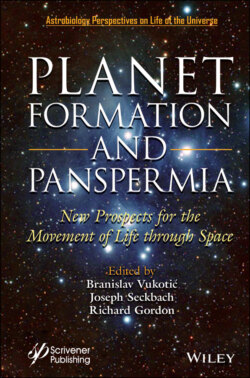Читать книгу Planet Formation and Panspermia - Группа авторов - Страница 2
Table of Contents
Оглавление1 Cover
2 Title page
3 Copyright
4 Preface References
5 Part I PHILOSOPHICAL ASPECTS OF PANSPERMIA 1 “On the Origin of Life” 2 Why We Should Take Interstellar Panspermia Seriously 2.1 Introduction 2.2 The Case for Interstellar Panspermia 2.3 Theoretical Consequences of Interstellar Panspermia 2.4 Conclusions References 3 The Extended Continuity Thesis, Chronocentrism, and Directed Panspermia 3.1 Introduction: The Continuity as a Pre-Requisite for Scientific Grounding of Astrobiology 3.2 Versions and Resistance 3.3 Cultural Evolution and Directed Panspermia 3.4 Conclusion and Prospects Acknowledgements References 4 Life in the Milky Way: The Panspermia Prospects 4.1 Introduction 4.2 Three Levels of Habitability and Panspermia 4.3 Conclusions Acknowledgements References
6 Part II MICROORGANISMS AND PANSPERMIA 5 Planetary Protection: Too Late 5.1 Introduction 5.2 What is Planetary Protection 5.3 Extent of Earth Biosphere 5.4 Extension to Other Planetary Bodies 5.5 Backward Contamination 5.6 Interplanetary Exchange 5.7 Habitable Conditions for Interplanetary Micronauts 5.8 Conclusion Appendix A Appendix B Appendix C Acknowledgments References 6 Microbial Survival and Adaptation in Extreme Terrestrial Environments— The Case of the Dallol Geothermal Area in Ethiopia 6.1 Introduction 6.2 Planetary Field Analog: The Case of the Dallol Geothermal Area 6.3 Life in Extreme Environments 6.4 Conclusion and Remarks on Panspermia Acknowledgements References 7 Escape From Planet Earth: From Directed Panspermia to Terraformation Acknowledgements References
7 Part III FORMATION AND EVOLUTION OF PLANETS: MATERIAL EXCHANGE PROSPECTS 8 Catalyzed Lithopanspermia Through Disk Capture of Biologically Active Interstellar Material 8.1 Introduction 8.2 Capture of Interstellar Planetesimals 8.3 Catalyzed Lithopanspermia 8.4 Conclusion and Discussion Acknowledgements References 9 Lithopanspermia at the Center of Spiral Galaxies 9.1 Introduction 9.2 The Kepler Transit Survey and the Distribution of Living Worlds 9.3 XUV Hydrodynamic Escape and the Formation of Habitable Evaporated Cores 9.4 Frequency of Exchange in High Stellar Densities 9.5 Detecting Panspermia 9.6 Concluding Remarks References 10 Wet Panspermia 10.1 Introduction 10.2 Earth and Its Isotopic World: Geological and Environmental Implications 10.3 Quest for the Primordial Water Worlds 10.4 Looking for the Biotic Traces in Extraterrestrial Material 10.5 Ices of the Moon and Proposal of Earth-Induced Wet Panspermia in the Solar System 10.6 Implications for Other Planets of the Inner Solar System? 10.7 Conclusions References 11 There Were Plenty of Day/Night Cycles That Could Have Accelerated an Origin of Life on Earth, Without Requiring Panspermia Acknowledgement References 12 Micrometeoroids as Carriers of Organics: Modeling of the Atmospheric Entry and Chemical Decomposition of Sub-Millimeter Grains 12.1 Micrometeorites and the Search for Life 12.2 White Soft Minerals 12.3 Atmospheric Entry Model 12.4 Results 12.5 The Role of Primordial Atmospheres 12.6 Conclusions References 13 Dynamical Evolution of Planetary Systems: Role of Planetesimals 13.1 Introduction 13.2 Planetesimal Formation and Evolution 13.3 Transporting Mechanism in Later Stages of Planetary System Evolution 13.4 Conclusion Acknowledgements References
8 Part IV FURTHER PROSPECTS 14 A Survey of Solar System and Galactic Objects With Pristine Surfaces That Record History and Perhaps Panspermia, With a Plan for Exploration 14.1 Introduction 14.2 Recording Properties 14.3 Pristine Potential of Solar System Bodies 14.4 Prospects and Conclusions Acknowledgements References 15 The Panspermia Publications of Sir Fred Hoyle Acknowledgements References
9 Index
10 Also of Interest
11 End User License Agreement
